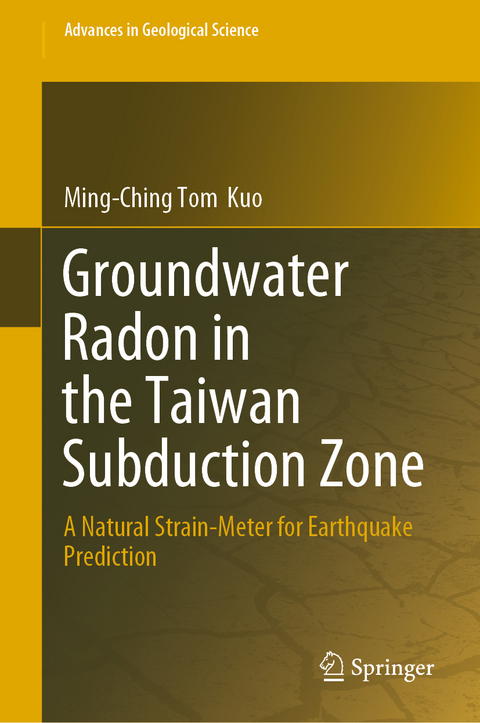
Groundwater Radon in the Taiwan Subduction Zone
Springer Verlag, Singapore
978-981-99-5349-3 (ISBN)
Between 2003 and 2010, anomalous declines in groundwater radon concentration were recurrently recorded at Antung, Taiwan, which are considered as precursory to local major earthquakes. The correlations between radon decline and earthquake magnitude are useful for early warning of local main earthquakes.
The book consists of 7 chapters. Chapter 1 presents background information and the objectives of the book. Chapter 2 illustrates the methods of monitoring groundwater radon and a brief review of earthquake prediction research using groundwater radon. Chapter 3 provides the details of anomalous decrease in groundwater radon before the Taiwan Mw 6.8 Chengkung Earthquake of 2003. Chapter 4 provides the description of the mechanism of groundwater-radon volatilization. Chapter 5 shows the recurrent anomalous declines in groundwater radon concentration consistently recorded at Antung, Taiwan, prior to local main earthquakes that occurred between 2003 and 2010. Monitoring groundwater radon in small, unconfined fractured aquifers is explained in Chapter 6, followed by an analysis of correlating precursory declines in groundwater radon, precursory time with earthquake magnitudes for small, confined fractured aquifers in Chapter 7.
Ming-Ching Tom Kuo, Ph.D., is a professor of petroleum engineering at National Cheng Kung University, Taiwan. He gained his industrial experience while working at Stanford Research Institute, Occidental Petroleum, and Mobil. He is experienced in oil, gas, and geothermal production. His research interests include groundwater hydrology, groundwater and soil remediation, and monitoring of groundwater radon. Since 2003, his research has focused on the applications of recurrent radon precursors to forecast local large earthquakes in the Taiwan subduction zone. Dr. Kuo earned his B.S. degree in chemical engineering from National Taiwan University, an M.S. in chemical engineering from Kansas State University, and a Ph.D. in environmental engineering from Stanford University.
1 Introduction1.1 Background and Objectives1.2 Organization of the BookReferences
2 Methods of Monitoring Groundwater Radon
2.1 Introduction2.2 Collection of Groundwater Samples2.2.1 Single-Phase Groundwater Samples2.2.2 Two-Phase Samples of Geo-Fluids 2.3 Determination of Radon Activity2.3.1 Liquid Scintillation Counting Method2.3.2 ZnS Scintillation Counting Method2.3.3 Continuous Measurement of Radon in Groundwater2.4 Radon Distributions in Groundwater near an Active Fault2.5 Application of Groundwater Radon for Earthquake Prediction ResearchReferences
3 Anomalous Radon Decline at Antung Hot Spring before the 2003 Mw 6.8 Chengkung Earthquake3.1 Introduction3.2 Radon Monitoring at Antung near the Longitudinal Valley Fault 3.3 Radon Anomaly before the 2003 Mw 6.8 Chengkung Earthquake3.4 Criticism of Radon as a PrecursorReferences
4 A Physical Mechanism of Groundwater-Radon Volatilization4.1 Introduction4.2 Suitable Geological Conditions4.3 In-Situ Radon-Volatilization Mechanism4.4 In-Situ Volatilization Mechanism for Groundwater-Dissolved GasReferences
5 Recurrences of Radon Anomalies Precursory to Local Main Earthquakes at Antung Hot Spring5.1 Introduction5.2 Recurrences of Radon Anomalies Observed at Antung D1 Well5.3 Aquifer Transmissivity as a Complementary Precursor5.4 Confirmation of In-Situ Volatilization Mechanism: Ruling out Hypothesis of Groundwater Mixing5.5 Favorable Geological Conditions for In-situ Gas-Bubble DevelopmentReferences
6 Anomalous Radon Declines in Small Unconfined Aquifers: Corroboration of Favorable Geological Conditions6.1 Introduction6.2 Geological Settings of Paihe Spring versus Antung Hot Spring6.3 Anomalous Radon Declines before the 2010 Mw 6.3 Jiasian and 2016 Mw 6.4 Meinong Earthquakes: Paihe Spring, Taiwan6.4 Anomalous Gas Declines before the 1984 M 6.8 Western Nagano Earthquake: Byakko Spring, JapanReferences
7 Anomalous Radon Declines in Small Confined Aquifers: Evaluation of Global Data7.1 Introduction7.2 Japan: Radon Anomaly before the 1978 Izu-Oshima-Kinkai Earthquake (M 7.0)7.3 Iceland: Radon Anomaly before the 1978 Southern Iceland Earthquake (ML 4.3)7.4 Taiwan: Correlations for Earthquake Prediction on the Longitudinal Valley Fault7.5 Future ProspectsReferences
| Erscheinungsdatum | 13.09.2023 |
|---|---|
| Reihe/Serie | Advances in Geological Science |
| Zusatzinfo | 12 Illustrations, color; 29 Illustrations, black and white; XIX, 83 p. 41 illus., 12 illus. in color. |
| Verlagsort | Singapore |
| Sprache | englisch |
| Maße | 155 x 235 mm |
| Themenwelt | Naturwissenschaften ► Biologie ► Ökologie / Naturschutz |
| Naturwissenschaften ► Geowissenschaften ► Geologie | |
| Naturwissenschaften ► Geowissenschaften ► Geophysik | |
| Schlagworte | Earthquake Precursor • Gas Bubbles • Groundwater Radon • Natural Strain Meter • Subduction zone |
| ISBN-10 | 981-99-5349-9 / 9819953499 |
| ISBN-13 | 978-981-99-5349-3 / 9789819953493 |
| Zustand | Neuware |
| Haben Sie eine Frage zum Produkt? |
aus dem Bereich


